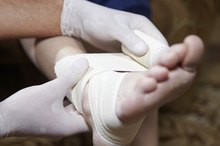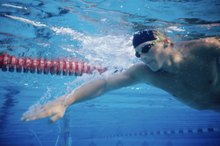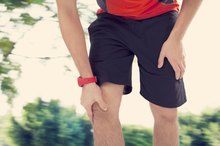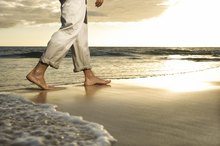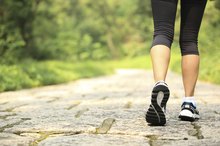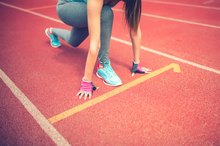Bicycling to Help With Knee Pain
The knee has more structures than any other joint, making it very vulnerable to injury and pain. It doesn’t help matters that it’s also a weight-bearing joint. Factors that contribute to knee pain include overuse, an unusual motion, abnormal joint structure or a degenerative condition such as arthritis. Exercises such as indoor bicycling can help to strengthen your knees and relieve pain.
Benefits
Bicycling strengthens muscles at the front your thighs, or the quadriceps muscles, which are the key protectors of the knees. Stronger muscles stabilize the knees and enable them to absorb shock better, thereby reducing damage and pain. It’s also a form of exercise that reduces rotational torque, or twisting, of the knee joint, unlike activities such as playing tennis or basketball. Also, exercise helps to lubricate knee joints, reduce swelling and suppress pain. Indoor cycling may be more beneficial for treating knee pain as it helps you to avoid extra shock from uneven terrain, accidents or disruption in your routine.
- Bicycling strengthens muscles at the front your thighs, or the quadriceps muscles, which are the key protectors of the knees.
- It’s also a form of exercise that reduces rotational torque, or twisting, of the knee joint, unlike activities such as playing tennis or basketball.
Bike Selection
Cycling & Patellar Tendonitis
Learn More
If you suffer from knee pain, back problems, are overweight or a senior, you might find a recumbent bike more comfortable. They have wider seats, supportive back rests and prevent you from having to climb up onto the seat as you would have to do with an upright bike. Make sure any bike you have has foot straps, which distribute the work between your quadriceps and hamstrings. Without straps, your quads do too much of the work.
- If you suffer from knee pain, back problems, are overweight or a senior, you might find a recumbent bike more comfortable.
- Make sure any bike you have has foot straps, which distribute the work between your quadriceps and hamstrings.
Form
Although cycling can relieve knee pain, it can also cause more injury if done incorrectly. Make sure the bicycle seat is level with the floor. If the seat points upward it places too much pressure on your groin; if pointing downward, it stresses your shoulders and arms. Place the saddle at a height that allows your knee to bend at a slight angle when it’s in the lowest pedal position. It’s also important to avoid sudden stops and starts during your workout, as this decreases blood flow to and lubrication of the joints.
- Although cycling can relieve knee pain, it can also cause more injury if done incorrectly.
- If the seat points upward it places too much pressure on your groin; if pointing downward, it stresses your shoulders and arms.
Caution
Foot Pain in the Heel From Playing Soccer
Learn More
If you have been suffering with recurring or long-term knee pain, consult with your doctor before you begin any exercise program. You should also seek medical advice if you have any existing health problems such as heart disease or diabetes. Ask your doctor or physical therapist how often you should cycle and for how long to avoid a knee injury due to overuse. Also, cycling should be only part of your knee treatment plan. You should also be doing other activities such as weight training and stretching exercises.
- If you have been suffering with recurring or long-term knee pain, consult with your doctor before you begin any exercise program.
- Ask your doctor or physical therapist how often you should cycle and for how long to avoid a knee injury due to overuse.
Related Articles
References
- Heal Your Knees; Dr. Robert Klapper and Lynda Huey
- Lespasio MJ, Piuzzi NS, Husni ME, Muschler GF, Guarino A, Mont MA. Knee Osteoarthritis: A Primer. Perm J. 2017;21:16-183. doi:10.7812/TPP/16-183
- Kiapour AM, Murray MM. Basic science of anterior cruciate ligament injury and repair. Bone Joint Res. 2014;3(2):20-31. doi:10.1302/2046-3758.32.2000241
- Doral MN, Bilge O, Huri G, Turhan E, Verdonk R. Modern treatment of meniscal tears. EFORT Open Rev. 2018;3(5):260-268. doi:10.1302/2058-5241.3.170067
- Reinking MF. CURRENT CONCEPTS IN THE TREATMENT OF PATELLAR TENDINOPATHY. Int J Sports Phys Ther. 2016;11(6):854-866.
- Petersen W, Rembitzki I, Liebau C. Patellofemoral pain in athletes. Open Access J Sports Med. 2017;8:143-154. doi:10.2147/OAJSM.S133406
- Frush TJ, Noyes FR. Baker's Cyst: Diagnostic and Surgical Considerations. Sports Health. 2015;7(4):359-65. doi:10.1177/1941738113520130
- Huang YC, Yeh WL. Endoscopic treatment of prepatellar bursitis. Int Orthop. 2011;35(3):355-8. doi:10.1007/s00264-010-1033-5
- Beals C, Flanigan D. A Review of Treatments for Iliotibial Band Syndrome in the Athletic Population. J Sports Med (Hindawi Publ Corp). 2013;2013:367169. doi:10.1155/2013/367169
- Tsai CH, Hsu CJ, Hung CH, Hsu HC. Primary traumatic patellar dislocation. J Orthop Surg Res. 2012;7:21. doi:10.1186/1749-799X-7-21
- Ragab G, Elshahaly M, Bardin T. Gout: An old disease in new perspective - A review. J Adv Res. 2017;8(5):495-511. doi:10.1016/j.jare.2017.04.008
- Lee PYF, Nixion A, Chandratreya A, Murray JM. Synovial Plica Syndrome of the Knee: A Commonly Overlooked Cause of Anterior Knee Pain. Surg J (N Y). 2017;3(1):e9-e16. doi:10.1055/s-0037-1598047
- Vaishya R, Azizi AT, Agarwal AK, Vijay V. Apophysitis of the Tibial Tuberosity (Osgood-Schlatter Disease): A Review. Cureus. 2016;8(9):e780. doi:10.7759/cureus.780
- Zanon G, Di vico G, Marullo M. Osteochondritis dissecans of the knee. Joints. 2014;2(1):29-36.
- Hindle P, Davidson E, Biant LC. Septic arthritis of the knee: the use and effect of antibiotics prior to diagnostic aspiration. Ann R Coll Surg Engl. 2012;94(5):351-5. doi:10.1308/003588412X13171221591015
- Gwinner C, Märdian S, Schwabe P, Schaser KD, Krapohl BD, Jung TM. Current concepts review: Fractures of the patella. GMS Interdiscip Plast Reconstr Surg DGPW. 2016;5:Doc01. doi:10.3205/iprs000080
- Voskuil R, Evenski AJ, Montgomery C, Emory CL. Malignant Bone Tumors of the Knee: How to Identify and Treat. J Knee Surg. 2019;32(4):305-314. doi:10.1055/s-0038-1675828
- Gupte C, St mart JP. The acute swollen knee: diagnosis and management. J R Soc Med. 2013;106(7):259-68. doi:10.1177/0141076813482831
- American Academy of Orthopedic Surgeons. Unstable Kneecap.
- Bhatia D, Bejarano T, Novo M. Current interventions in the management of knee osteoarthritis. Journal of Pharmacy & Bioallied Sciences 2013 Jan-Mar;5(1):30-38. doi:%2010.4103/0975-7406.106561
- Bronstein RD, Schaffer JC. Physical Examination of the Knee: Meniscus, Cartilage, and Patellofemoral Conditions. J Am Acad Orthop Surg. 2017 May;25(5):365-374.
- Browne K, Kurtz CA. How to perform a comprehensive examination of the knee. JAAPA. 2009 Jun;22(6):20-25.
- Hergenroeder AC, Harvey BS. (2017). Osteochondritis dissecans (OCD): Clinical manifestations and diagnosis. Bachur RG, ed. UpToDate. Waltham, MA: UpToDate Inc.
Resources
Writer Bio
Kay Uzoma has been writing professionally since 1999. Her work has appeared in "Reader’s Digest," "Balance," pharmaceutical and natural health newsletters and on websites such as QualityHealth.com. She is a former editor for a national Canadian magazine and holds a Bachelor of Arts in political science from York University.

